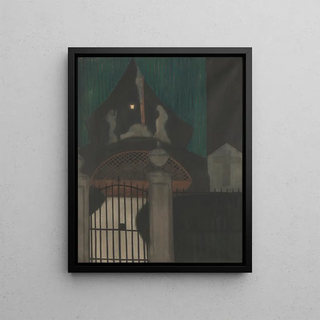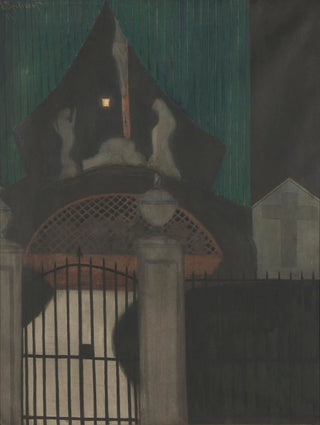Art print | Calvary and Purgatory in the Orient - Léon Spilliaert


View from behind

Frame (optional)
Art print Calvaire et purgatoire en Orient - Léon Spilliaert – Captivating introduction
In the fascinating universe of art, some works transcend their era to become witnesses of a unique sensitivity. "Calvaire et purgatoire en Orient - Léon Spilliaert" is a striking example. This piece, imbued with a mysterious atmosphere and emotional depth, invites the viewer to an introspective exploration. Spilliaert, with his distinctive style, manages to capture the very essence of the human condition, oscillating between light and darkness, the tangible and the ephemeral. Contemplating this work, one is immediately transported to a world where the boundaries between reality and imagination fade, offering an unforgettable visual and spiritual experience.
Style and uniqueness of the work
Spilliaert's work is distinguished by its palette of dark colors and bold compositions, which create a striking sense of depth. In "Calvaire et purgatoire en Orient," the sinuous lines and organic shapes intertwine to evoke a feeling of movement and life. The mastery of light and shadow is particularly remarkable, with each element carefully arranged to enhance the emotional impact of the scene. The human figures, often depicted in contemplative postures, seem to dialogue with their environment, adding a narrative dimension to the piece. This blend of symbolism and expressionism makes this work an emblematic achievement of modern art, while maintaining a singularity that is uniquely its own.
The artist and his influence
Léon Spilliaert, born in Ostend in 1881, is an artist who managed to mark his era with his innovative approach and personal vision. Influenced by symbolism and expressionism, he developed a style that is uniquely his own, characterized by deep introspection and an exploration of themes of isolation and melancholy. His work is often perceived as a reflection of his own inner struggles, but also as a meditation on the human condition in a constantly changing world. Spilliaert established himself on the Belgian and international art scene, and his legacy continues to inspire many

Matte finish

View from behind

Frame (optional)
Art print Calvaire et purgatoire en Orient - Léon Spilliaert – Captivating introduction
In the fascinating universe of art, some works transcend their era to become witnesses of a unique sensitivity. "Calvaire et purgatoire en Orient - Léon Spilliaert" is a striking example. This piece, imbued with a mysterious atmosphere and emotional depth, invites the viewer to an introspective exploration. Spilliaert, with his distinctive style, manages to capture the very essence of the human condition, oscillating between light and darkness, the tangible and the ephemeral. Contemplating this work, one is immediately transported to a world where the boundaries between reality and imagination fade, offering an unforgettable visual and spiritual experience.
Style and uniqueness of the work
Spilliaert's work is distinguished by its palette of dark colors and bold compositions, which create a striking sense of depth. In "Calvaire et purgatoire en Orient," the sinuous lines and organic shapes intertwine to evoke a feeling of movement and life. The mastery of light and shadow is particularly remarkable, with each element carefully arranged to enhance the emotional impact of the scene. The human figures, often depicted in contemplative postures, seem to dialogue with their environment, adding a narrative dimension to the piece. This blend of symbolism and expressionism makes this work an emblematic achievement of modern art, while maintaining a singularity that is uniquely its own.
The artist and his influence
Léon Spilliaert, born in Ostend in 1881, is an artist who managed to mark his era with his innovative approach and personal vision. Influenced by symbolism and expressionism, he developed a style that is uniquely his own, characterized by deep introspection and an exploration of themes of isolation and melancholy. His work is often perceived as a reflection of his own inner struggles, but also as a meditation on the human condition in a constantly changing world. Spilliaert established himself on the Belgian and international art scene, and his legacy continues to inspire many






